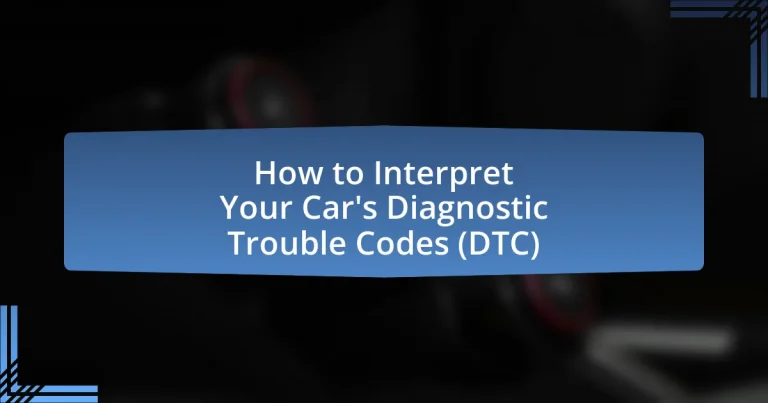Diagnostic Trouble Codes (DTC) are standardized alphanumeric codes generated by a vehicle’s onboard diagnostic system to identify specific malfunctions within its engine and other systems. This article provides a comprehensive overview of DTCs, including their generation, significance for vehicle maintenance, and the role of onboard diagnostics and sensors in their creation. It explains how to read and interpret DTCs using OBD-II scanners, the differences between basic and advanced diagnostic tools, and best practices for troubleshooting issues based on these codes. Additionally, the article highlights common DTCs, their meanings, and the importance of timely interpretation for effective vehicle repair and maintenance.
-1.webp)
What are Diagnostic Trouble Codes (DTC)?
Diagnostic Trouble Codes (DTC) are standardized codes used by automotive diagnostic systems to identify specific issues within a vehicle’s engine or other systems. Each DTC corresponds to a particular fault or malfunction, allowing technicians to quickly pinpoint problems during vehicle diagnostics. For example, a code like P0301 indicates a misfire in cylinder one, providing a clear direction for troubleshooting. DTCs are essential for efficient vehicle maintenance and repair, as they streamline the diagnostic process and enhance communication between vehicles and diagnostic tools.
How are DTCs generated in vehicles?
Diagnostic Trouble Codes (DTCs) are generated in vehicles when the onboard diagnostic system detects a malfunction in a vehicle’s components or systems. This system continuously monitors various sensors and components, such as the engine, transmission, and emissions systems, using predefined parameters. When a sensor reports a value outside of these parameters, the onboard diagnostic system triggers a DTC, which is a specific alphanumeric code that identifies the issue. For example, if the oxygen sensor detects an incorrect air-fuel mixture, it will generate a corresponding DTC, allowing technicians to diagnose and address the problem effectively.
What role do onboard diagnostics play in DTC generation?
Onboard diagnostics (OBD) play a crucial role in the generation of diagnostic trouble codes (DTC) by continuously monitoring the performance of a vehicle’s engine and other critical systems. OBD systems utilize sensors and control modules to detect malfunctions or deviations from normal operating conditions, which trigger the creation of specific DTCs that indicate the nature of the issue. For instance, when a sensor detects an abnormal reading, the OBD system logs a corresponding DTC, allowing technicians to identify and address the problem efficiently. This process is standardized across vehicles, with OBD-II protocols defining the format and meaning of DTCs, ensuring consistency in diagnostics across different manufacturers and models.
How do sensors contribute to the creation of DTCs?
Sensors play a crucial role in the creation of Diagnostic Trouble Codes (DTCs) by monitoring various parameters of a vehicle’s performance and detecting anomalies. These sensors, such as oxygen sensors, mass airflow sensors, and temperature sensors, collect data on engine conditions, emissions, and other critical systems. When a sensor detects a value outside of its normal operating range, it triggers the vehicle’s onboard diagnostic system to generate a specific DTC that indicates the nature of the issue. For instance, if an oxygen sensor reports an incorrect air-fuel mixture, the system will log a DTC related to fuel system performance, allowing technicians to identify and address the problem efficiently. This process ensures that vehicles maintain optimal performance and comply with emissions regulations.
Why are DTCs important for vehicle maintenance?
DTCs, or Diagnostic Trouble Codes, are crucial for vehicle maintenance because they provide specific information about malfunctions within a vehicle’s systems. These codes help technicians identify issues quickly, allowing for targeted repairs rather than guesswork. For instance, a DTC related to the engine may indicate a problem with the fuel system, ignition system, or emissions control, enabling efficient troubleshooting. The use of DTCs can significantly reduce diagnostic time and costs, as studies show that vehicles diagnosed with DTCs can be repaired 30% faster than those without.
How can DTCs help in identifying vehicle issues?
Diagnostic Trouble Codes (DTCs) help in identifying vehicle issues by providing specific alphanumeric codes that correspond to faults detected by the vehicle’s onboard diagnostic system. Each DTC is linked to a particular problem, such as engine misfires or sensor failures, allowing technicians to quickly pinpoint the source of the issue. For example, a code like P0301 indicates a misfire in cylinder one, directing the technician to investigate that specific area. This targeted approach reduces diagnostic time and improves repair accuracy, ultimately enhancing vehicle reliability and performance.
What is the significance of timely DTC interpretation?
Timely interpretation of Diagnostic Trouble Codes (DTC) is crucial for effective vehicle maintenance and repair. Quick identification of issues allows for prompt action, which can prevent further damage to the vehicle and reduce repair costs. For instance, a study by the Automotive Service Association indicates that addressing DTCs within a week can save vehicle owners up to 30% in potential repair expenses. Additionally, timely DTC interpretation enhances vehicle safety by ensuring that critical malfunctions are resolved before they lead to accidents.

How can you read and understand DTCs?
To read and understand Diagnostic Trouble Codes (DTCs), one must use an OBD-II scanner to retrieve the codes from the vehicle’s onboard computer. The OBD-II system generates codes that correspond to specific issues within the vehicle, allowing for precise identification of malfunctions. Each DTC consists of a letter followed by four digits, where the letter indicates the system (e.g., P for powertrain, B for body, C for chassis, and U for network). For example, a code like P0301 signifies a misfire in cylinder one. Understanding these codes requires referencing a repair manual or online database that provides definitions and troubleshooting steps for each specific code, ensuring accurate diagnosis and repair.
What tools are needed to read DTCs?
To read Diagnostic Trouble Codes (DTCs), an OBD-II scanner is essential. This tool connects to a vehicle’s onboard diagnostics port, allowing users to retrieve and interpret the codes generated by the vehicle’s computer system. OBD-II scanners vary in complexity, from basic code readers that display trouble codes to advanced diagnostic tools that provide live data and troubleshooting information. The necessity of an OBD-II scanner is supported by the fact that all vehicles manufactured after 1996 are required to be OBD-II compliant, making this tool universally applicable for modern vehicles.
How do OBD-II scanners work?
OBD-II scanners work by connecting to a vehicle’s onboard diagnostics system to retrieve diagnostic trouble codes (DTCs) and other data. These scanners communicate with the vehicle’s Engine Control Unit (ECU) through a standardized connector, typically located under the dashboard. When the scanner is plugged in and activated, it sends requests for information, and the ECU responds by providing data related to the vehicle’s performance, emissions, and any detected faults. This process allows users to identify issues, as the DTCs correspond to specific problems within the vehicle, enabling effective troubleshooting and repairs.
What are the differences between basic and advanced diagnostic tools?
Basic diagnostic tools primarily read and clear Diagnostic Trouble Codes (DTCs), while advanced diagnostic tools offer comprehensive vehicle data analysis, including live data streaming, advanced troubleshooting capabilities, and enhanced functionality for specific systems. Basic tools typically provide limited information, focusing on error codes and basic vehicle parameters, whereas advanced tools can perform in-depth diagnostics, including component activation and system tests, allowing for more precise identification of issues. For instance, advanced tools can access manufacturer-specific codes and perform bi-directional tests, which basic tools cannot, thus enabling a more thorough understanding of vehicle performance and faults.
How do you interpret the meaning of DTCs?
DTCs, or Diagnostic Trouble Codes, are alphanumeric codes generated by a vehicle’s onboard diagnostic system to indicate specific issues or malfunctions within the vehicle. Each DTC corresponds to a particular problem, allowing technicians and vehicle owners to identify and address issues efficiently. For example, a code like P0301 signifies a misfire in cylinder one, providing a clear direction for troubleshooting. The interpretation of DTCs is essential for effective vehicle maintenance and repair, as it enables targeted diagnostics rather than guesswork.
What do the alphanumeric codes represent?
Alphanumeric codes represent Diagnostic Trouble Codes (DTCs) used in automotive diagnostics to identify specific issues within a vehicle’s systems. Each code corresponds to a particular fault or malfunction, allowing technicians to pinpoint problems efficiently. For example, a code like P0420 indicates a catalytic converter efficiency issue, providing a clear direction for repairs. These codes are standardized by the Society of Automotive Engineers (SAE), ensuring consistency across different vehicle makes and models, which facilitates accurate diagnostics and repairs.
How can you find the definitions of specific DTCs?
You can find the definitions of specific Diagnostic Trouble Codes (DTCs) by consulting the vehicle’s service manual or using online databases dedicated to automotive diagnostics. Service manuals typically provide detailed explanations of each DTC, including potential causes and troubleshooting steps. Online resources, such as websites like OBD-Codes.com or manufacturer-specific forums, also offer comprehensive lists and definitions of DTCs, often updated with user-contributed insights and experiences. These sources ensure accurate and relevant information for interpreting DTCs effectively.

What are common DTCs and their meanings?
Common Diagnostic Trouble Codes (DTCs) include P0300, P0420, and P0171, each indicating specific issues in a vehicle. P0300 signifies a random/multiple cylinder misfire, suggesting that the engine is not firing properly, which can lead to reduced performance and increased emissions. P0420 indicates a catalyst system efficiency below the threshold, often pointing to a failing catalytic converter or exhaust leak, which can affect emissions control. P0171 denotes a system too lean condition, meaning there is an insufficient fuel supply or excessive air intake, potentially leading to engine performance issues. These codes are standardized and can be referenced in repair manuals or automotive diagnostic tools for further troubleshooting.
What are some frequently encountered DTCs?
Some frequently encountered Diagnostic Trouble Codes (DTCs) include P0420, P0300, and P0171. P0420 indicates a problem with the catalytic converter’s efficiency, often linked to exhaust system issues. P0300 signifies random or multiple cylinder misfires, which can stem from ignition system failures or fuel delivery problems. P0171 points to a lean fuel mixture, typically caused by vacuum leaks or fuel system malfunctions. These codes are commonly retrieved using an OBD-II scanner, which helps diagnose vehicle issues effectively.
How do P0XXX codes differ from P1XXX codes?
P0XXX codes indicate generic powertrain issues that are standardized across all vehicle makes and models, while P1XXX codes are manufacturer-specific and pertain to unique issues relevant to a particular brand or model. The distinction lies in the universality of P0XXX codes, which can be interpreted by any OBD-II compliant scanner, whereas P1XXX codes require specific knowledge of the manufacturer’s diagnostic protocols to understand the underlying issues. This classification system helps technicians quickly identify whether a problem is common across various vehicles or specific to a particular manufacturer, facilitating more efficient troubleshooting and repairs.
What do manufacturer-specific codes indicate?
Manufacturer-specific codes indicate unique diagnostic trouble codes (DTCs) that are defined by individual vehicle manufacturers to identify specific issues within their vehicles. These codes provide detailed information about malfunctions that may not be covered by generic codes, allowing for more precise diagnostics and repairs tailored to the vehicle’s make and model. For example, while a generic code may indicate a general issue with the engine, a manufacturer-specific code can pinpoint the exact sensor or component that is malfunctioning, enhancing the accuracy of troubleshooting efforts.
How can you troubleshoot issues based on DTCs?
To troubleshoot issues based on Diagnostic Trouble Codes (DTCs), first retrieve the DTCs using an OBD-II scanner, which provides specific codes indicating the nature of the problem. Next, consult a repair manual or an online database to interpret the codes, as each code corresponds to a specific issue within the vehicle’s systems. For example, a code P0420 indicates a problem with the catalytic converter’s efficiency. After identifying the issue, inspect the related components, perform necessary tests, and replace or repair faulty parts as indicated by the diagnostic information. This systematic approach ensures accurate identification and resolution of vehicle issues, enhancing reliability and performance.
What steps should you take after retrieving a DTC?
After retrieving a Diagnostic Trouble Code (DTC), the first step is to document the code and any related symptoms. This documentation helps in diagnosing the issue accurately. Next, research the specific DTC using reliable automotive resources or databases to understand its meaning and implications. Following this, inspect the vehicle for any obvious issues related to the DTC, such as damaged wiring or loose connections. If necessary, clear the DTC using an OBD-II scanner and perform a test drive to see if the code reappears, indicating whether the issue persists. Finally, if the problem remains unresolved, consider consulting a professional mechanic for further diagnosis and repair.
How can you prioritize repairs based on DTC severity?
To prioritize repairs based on DTC severity, first categorize the Diagnostic Trouble Codes into three levels: critical, major, and minor. Critical codes indicate immediate safety risks or severe engine performance issues, necessitating urgent repairs. Major codes suggest significant problems that could lead to further damage if not addressed promptly, while minor codes represent less urgent issues that can be scheduled for later repair.
For example, a critical code like P0300 (random/multiple cylinder misfire detected) requires immediate attention to prevent engine damage, whereas a minor code like P0420 (catalytic converter efficiency below threshold) can be monitored over time. This systematic approach ensures that the most severe issues are addressed first, optimizing vehicle safety and performance.
What are best practices for interpreting DTCs?
Best practices for interpreting Diagnostic Trouble Codes (DTCs) include understanding the code definitions, using a reliable code reader, and considering the context of the vehicle’s symptoms. Accurate interpretation begins with referencing the specific DTC against manufacturer databases or trusted automotive resources to grasp its meaning. Employing a quality OBD-II scanner ensures that the codes retrieved are precise and up-to-date. Additionally, correlating the DTC with the vehicle’s performance issues, such as unusual sounds or warning lights, provides critical context that aids in diagnosing the problem effectively. This approach enhances the accuracy of troubleshooting and repairs, ultimately leading to better vehicle maintenance outcomes.
How often should you check for DTCs in your vehicle?
You should check for Diagnostic Trouble Codes (DTCs) in your vehicle at least once every month or whenever the check engine light activates. Regular checks help identify potential issues early, preventing more significant problems and costly repairs. According to the National Highway Traffic Safety Administration, timely detection of DTCs can enhance vehicle safety and reliability.
What resources can assist in understanding DTCs better?
To understand Diagnostic Trouble Codes (DTCs) better, automotive repair manuals and online databases are essential resources. Automotive repair manuals, such as those from Haynes or Chilton, provide detailed explanations of DTCs, including their meanings and troubleshooting steps. Online databases like the National Highway Traffic Safety Administration (NHTSA) and manufacturer-specific websites offer access to DTC definitions and repair guidelines. These resources are validated by industry standards and are widely used by mechanics and automotive professionals for accurate diagnostics and repairs.


